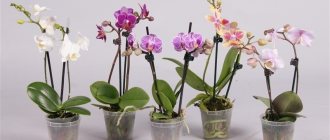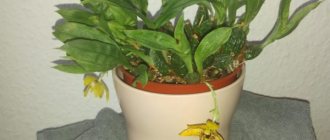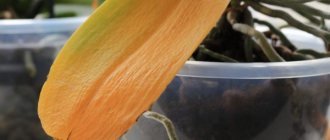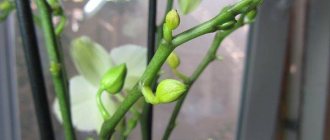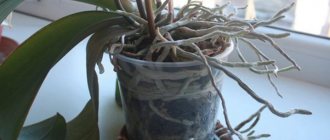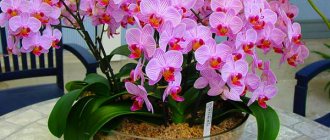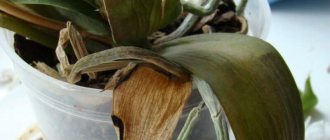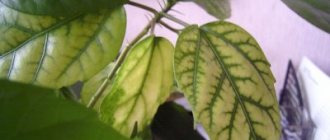The main reasons for broken peduncles in orchids
Inexperienced orchidists sometimes ignore the fact that before flowering it is necessary to immediately tie the arrow with the buds and direct it in the right direction. In phalaenopsis, the arrow emerges from under the bottom leaf and can then grow parallel to the floor. If it is not tied to a support in time, it will soon break from the weight of buds and flowers. The support is inserted into the pot as soon as the peduncle appears, and it is attached to the support using hooks that do not interfere with the further blooming of the flowers. Such fastening allows not only to reduce the breakdown of the peduncle to zero, but also to control the direction of the growing shoot.
But there are also a number of subjective reasons for damage to arrows with buds. This:
- Poorly chosen place, cramped space. To get to each plant you need to move the pots, and orchids don’t like to be disturbed. Moving pots from place to place increases the risk of harming the peduncle.
- Presence of pets in the house. Cats throw flower pots onto the floor, damaging leaves and shoots with buds and flowers. Pets should have limited access to the room with orchids.
Why is this happening?
Drying of the peduncle is not always a natural process ; it is often provoked by external factors.
Incorrect lighting . If an orchid does not have enough light, not only the flower stalks dry out, but also the leaves, aerial roots, and incompletely formed buds, and photosynthesis also slows down. However, we must not forget that both bright light and direct sunlight are dangerous for the flower. It is best to place the orchid in partial shade.- Excess or deficiency of nutrients . Using fertilizers too frequently will cause more harm to the orchid than benefit: its leaves, peduncle, roots will begin to dry out, and the buds will fall off. If there is a lack of nutrition, the plant will develop too slowly or not at all.
- Air humidity . Due to an insufficient level of air humidity, in a dry climate, the general condition of the plant will deteriorate, unopened flowers will fall off, the peduncle will dry out, and with excess humidity, the process of rotting may begin.
- Hypothermia . The air temperature should not be lower than +14 degrees. Due to hypothermia, the orchid will drop its buds and the peduncle will wither. Do not place the plant under air conditioning or ventilate the room frequently and for a long time in winter.
- Overheating of roots . Orchids love warmth, but you should still overheat them. Do not leave the plant in direct sunlight, near a heating radiator in winter, or under hot air from an air conditioner.
- Stress . If you “relocate” an orchid to a new place, it will experience shock, as the light, temperature, and air humidity will change. The consequence of such stress will be the cessation of flowering and the dropping of buds.
You should not turn the pot with the orchid in relation to the light in order to ensure uniform natural lighting - the plant will regard such actions as stress for itself.
The arrow is broken
If a broken peduncle or its tip is found on a plant, inspect the place of the break. There is no point in leaving the arrow hanging on one skin; it will dry out in any case. Wrapping the wound with tape or band-aid does not bring any results. The broken part is removed in any situation. But, there are pruning features depending on the location of the damage.
If an orchid has a broken peduncle, but there is a living bud below the damage, then most likely it will wake up and the plant will shoot a new arrow from this bud. After all, phalaenopsis is already ready to bloom. It will be more modest, but will still please the owner. It's a completely different matter when the peduncle breaks off at the very base. In this case, the arrow is cut off completely; it will still dry out, and the grower will have to wait until the orchid produces a new shoot.
Experts in growing orchids believe that damaging the arrow and removing it does not harm the plant and does not affect its further development. You can even see some benefit in this. By removing the broken arrow, the owner stimulates the flower to throw out a stronger peduncle.
Attention! If signs of any disease are detected in the orchid, flowering is stopped artificially so that the plant has the strength to recover.
Trimming
Pruning of the peduncle is done with a sharp sterilized instrument in the following cases:
- Its damage. When a peduncle is broken, it is cut off with a sharp, densified instrument just above the first living bud or at the base if the arrow is broken at the very bottom. The cut area is sprinkled with dry cinnamon, finely ground activated charcoal or charcoal.
- When the flower stalk has faded. In this situation, the cut is made above the first living bud, going up 1 cm.
- The arrow began to turn yellow and dry out at the top. In this way the plant shows that it does not need a peduncle. Pruning is carried out above the lowest living bud. After resting, the orchid will produce a new shoot from this bud for flowering.
Broken flowering branch
Beginners who are faced with the problem of a broken arrow for the first time do not know what to do. If an orchid has a broken peduncle with blooming flowers or swollen buds, it is cut off with a sharp stationery knife or a special device and placed in water. An arrow with blooming flowers can delight the owner for from 2 weeks to several months. And the best way to avoid breaking a flowering branch is to tie it to a support.
Orchid restoration
After damage and removal of the peduncle, the orchid needs a certain time to recover, which can last from 2 to 6 months. Most often, the recovery period is painless, and the orchid produces a new shoot with buds. But the owner needs to provide the green pet with:
- suitable temperature conditions;
- lighting;
- air humidity.
Bud fading and growth stimulator
Sometimes orchid growers stumble upon yet another problem and don’t know what to do. The orchid's peduncle is partially broken, 1 or 2 buds remain, but they do not dry out or develop. To awaken them, cytokinin paste is used. In order not to destroy the kidney, but to give an impetus to its development, do the following:
- A toothpick or needle is treated with alcohol.
- Carefully bend back the scales covering the bud.
- Apply a drop of paste to a toothpick and cover the surface of the kidney with it.
- Provide a difference between night and day temperatures of 2-3 degrees.
- When two shoots appear from a bud, one is removed and the cut is sprinkled with crushed activated carbon.
Attention!
Different amounts of paste used will give different results. An increase in the stimulant can give rise to shoots - babies or lead to drying out of the bud.
You may be interested in:
The orchid (Phalaenopsis) has faded - what to do next? Phalaenopsis is one of the most common and low-maintenance types of orchids. As a rule, in stores...Read more...
What are the types of peduncle damage?
Do not despair if the flower arrow of an orchid breaks; all is not lost. There is a way out of an unpleasant situation, and more than one. The plant can be saved, but first it is worth assessing the damage caused:
- The stem was partially broken , and some of the lower flower buds were preserved. As a rule, the remaining buds bloom without any additional effort.
- The peduncle came off completely, but one bud remained at the base . In most cases, a new stem grows from it. Most often it is thinner and shorter, with smaller flowers than it was before the breakage.
- After damage , the flower shoot dried out completely. Then serious resuscitation measures are necessary.
The success of resuscitation depends on the degree of damage and the age of the plant. Young orchids can withstand damage more easily than older plants. During recovery, it is especially important to maintain optimal conditions - temperature, lighting and air humidity. Also, it is necessary to pay attention to protecting the plant from infection by diseases and pests.
Read more about what to do if the peduncle of an orchid breaks.
Disease Prevention
When growing their plants, orchids are sometimes faced with the complete drying out of the stem left from a broken branch. To prevent drying out of the entire above-ground part of the plant, the shoot is cut with a sharp stationery knife treated with alcohol or chlorhexidine. If part of the base is affected, it is cut off to healthy tissue. After the surgical procedure, the cut is allowed to dry and sprinkled with crushed activated charcoal or charcoal to eliminate microbes through open wounds.
The second preventive measure to save the plant is the treatment of the above-ground part of the flower with biological preparations. Their use will not harm the flower, the owner, or pets. Used for processing:
- phytosporin (alirin, gamair);
- mikosan;
- Glycladin.
The preparations are diluted according to the instructions and treated not only the green parts of the plant, but also the substrate in which the orchid is grown, since the main part of the fungal pathogens live there; when they evaporate, they rise into the air and end up in open wounds. In this case, we are talking about saving the flower, and not about the formation of a new flower shoot.
When the broken peduncle dries out
If the broken stem begins to dry out, there is a risk that this process will take over the rest of the flower. To avoid this, the dried part of the peduncle must be removed. You can use scissors for this, but a stationery knife is more suitable, since its thin blade makes it much easier to make a neat cut. Before removing the dried part of the stem, the knife must be treated with alcohol. Trim the stem back to living tissue. After this, wait until the juice from the wound stops oozing and treat it with an antiseptic.
If the peduncle is removed, a new one will no longer grow in this place. Nevertheless, you still need to trim the dry stem, because this is the only way to save the entire orchid. To enhance plant protection, treat it with a fungicide of biological origin, for example, Mikosan, Fitosporin or Glycadin. The listed drugs are harmless to the environment, humans and animals.
The purchased drug must be prepared strictly according to the instructions that come with each package. The solution is sprayed onto the substrate and the above-ground part of the orchid. This will protect the plant from the development of most diseases to which the flower is susceptible.
A broken peduncle will not cause serious injury to the plant. After some time, a new stem will appear, and the orchid will begin to bloom again. But if you do not want to lose the peduncle and wait for a new one to grow, do not forget to tie the stem to an additional support immediately after its formation. The support must be strong enough to support the heavy peduncle without damaging it.
Resuscitation of the root system
If, as a result of the actions taken, there is no improvement in the condition of the flower, but rotting of the roots has begun, then:
- leaves lose their elasticity, wrinkle, dry out;
- the plant does not hold well in the substrate and sways;
- the roots lose their green color and become slimy and black.
The main cause of rot is improper watering. Proper care involves alternating moisture with periods of dryness. The reason is the special structure of the orchid roots, covered on top with a special layer called velamen. Its main function is the ability, like a sponge, to absorb moisture from the air and substrate, and if there is an excess of it, and aeration is poor, and there is no drain to remove excess water, then velamen begins to sour and decompose.
If the orchid is suspected of rotting of the root system, immediately remove it from the container and inspect the roots. Resuscitation procedures are carried out in several stages:
- All slimy and blackened parts are removed down to healthy tissue. This can be seen in the light cut. If there are flower shoots, they are removed.
- The sections are disinfected and dried. Several crystals of potassium permanganate are dissolved in clean water to obtain a pink solution.
- The root system is immersed in the solution for 3 minutes.
- Then the plant is laid out on a towel to dry.
- The sections are treated with cinnamon, crushed activated charcoal or charcoal, and brilliant green.
- Leave for several hours for the wounds to dry completely.
You may be interested in:
How to save an orchid if its roots have rotted: tips, instructions An orchid can get sick and die as a result. Timely resuscitation measures will help return the plant to...Read more...
Aftercare of the plant
Further care of the flower is no less important. For the first time after the manipulation, it is better to leave the plant alone.
To prevent the flower from drying out and recovering, it should create suitable conditions:
- Good and sufficient lighting. Daylight hours should be about 9–12 hours. In autumn it is provided with the help of artificial lighting. At first, it is better not to keep the plant in the light.
- Stable temperature conditions. During the day, the readings should be within +22...+24°C, at night - +16...+18°C.
- Optimal air humidity. It should be in the range of 50–80%. In warm weather, the flower is regularly sprayed.
- Watering. This is the most important criterion for an orchid. This flower does not tolerate drought, but also reacts no less critically to excessive watering. Moisten the substrate only with soft, settled water. The ideal option is rain or boiled water. Do not water the plant with tap water. The first watering is carried out only 2 days after transplantation.
- No drafts. Regular ventilation will not harm the plant (it needs fresh air). But constantly being in the path of cold air can destroy the flower.
- Regular feeding. Like any plant, an orchid needs to be fertilized. It is enough to fertilize 1-2 times a month. They use special complexes for orchids. In the first month after transplantation, the flower is not fed.
Did you know? The largest inflorescence is the orchid Paphiopedilum sanderianum.
On average, the length of its petals reaches 90 cm. And the largest orchids grow up to 20 m in height. By following simple rules of care, you can get a magnificent flower that will delight you with its bloom for a long time. The main condition is to follow all recommendations and be attentive to the plant.
Growing new roots
The next step in saving the orchid is choosing the conditions for growing a new root system. And the main task is to stimulate the orchid to form roots. There are 2 fundamentally different methods:
- Conditionally wet. It is used in cases where the plant has lost all its roots.
- Conditionally dry. Used when part of the roots is preserved.
Conditionally wet method
Sphagnum moss spilled with water is placed in a container or glass jar. The plant is placed above it so that the base of the root collar does not reach the level of the moss by a few millimeters. The top of the greenhouse is covered with a plastic bag.
Attention!
Using this method, you can do without a substrate. Orchids are hung in closed containers with high humidity. New roots grow in the air, and do not go into the substrate, build up good velamen and have a healthy green color. Sometimes plant roots are grown in water, but this method is one of the most rarely used.
Conditionally dry method
In this method of growing the root system, a vessel (container, glass jar) is used, at the bottom of which clean, dry bark is poured. An orchid is planted in it and covered with a lid with ventilation holes. Leave unchanged for 3-5 days. Next, begin careful and careful watering along the edge of the container. After about a month, young roots appear.
Growing containers
A variety of containers are suitable for creating a greenhouse. The main thing that is necessary for the resuscitation of orchids is light, the presence of ventilation holes, and the same ambient temperature. The following are used as such greenhouses:
- glass jars;
- 5-liter bottles cut into 2 parts;
- old aquariums;
- food plastic containers.
You may be interested in:
How to properly prune an orchid after flowering: basic pruning rules Orchids such as phalaenopsis bloom twice a year. The period lasts about two weeks, and another type of it...Read more...
The orchid is one of the most capricious and mysterious flowers, but with skillful care it thanks to flowering that lasts up to 6 months. Therefore, gardeners who have achieved orchid flowering at home are considered professionals in their field. They are able to provide the plant with such care that the phalaenopsis produces and is able to provide food for more than 3 arrows at the same time.
Green root and stem death
Orchid can be found in many modern apartments. Many phalaenopsis lovers do not know the basic points of caring for the plant. Orchids sold in stores are hybrids bred for indoor living. In cases where a flower falls off a peduncle or the leaves turn yellow and fall off, the processes of photosynthesis and moisture evaporation do not occur, then it is necessary to help the plant.
If the stem dies, the main attention should be paid to the root system. It is necessary to conduct a detailed study of it.
If the root system has green buds, you can try to restore it. You need to feed your pet with fertilizer containing nitrogen and adding a growth stimulant. If the plant is susceptible to treatment, then within a few months the flower will begin to grow and may begin to bloom.
When using drugs to enhance growth, phalaenopsis will produce new roots. To grow new shoots and roots, it is good to use stimulating complexes:
To improve flowering, leaves should be treated with dissolved succinic acid. It improves immunity, activates the growth of the root system and promotes the growth of green young shoots.
An orchid is a demanding and capricious flower. For its proper development and growth, it is necessary to comply with growing conditions, maintain optimal temperature, light and humidity. It is necessary to regularly feed and protect from various damages.
When a peduncle appears, be sure to use a stem support. When adding up all the growing rules, the plant’s roots will be strong and the flowering will be long. Beautiful tropical flowers will serve as a reward for a caring owner.
Features of aerial roots
In this exotic beauty, which is present on the windowsill in almost every home, part of the root system is located above the pot and is called aerial roots. They have a flat or cylindrical shape and are thick. The roots are covered with a silver-gray shell, which acquires a green tint when wet, the structure of which is similar to a sponge.
Thanks to this sponge, the flower receives moisture from rain and fog, growing in natural conditions. Under the influence of the sun and heat, this shell, called velamen, allows the roots not to dry out, since the vascular-type bundles underneath act as a kind of reservoir for water reserves.
Young aerial roots are colored light green, while old ones are pale and muted in color. The presence and number of such shoots should not frighten gardeners when purchasing a plant. Since in the wild flowers grow on rocky cliffs, in gorges and on trees, they need aerial roots as a source of nutrients. It is more important to assess the external condition - they must be healthy and have no signs of rot.

